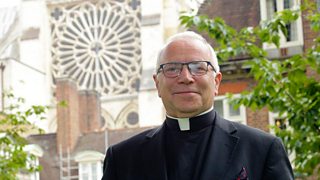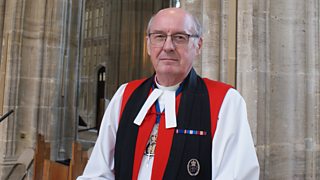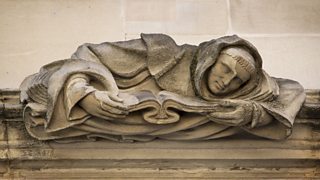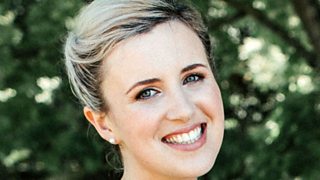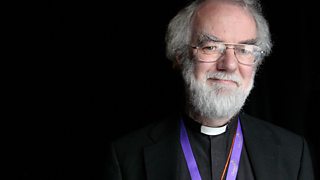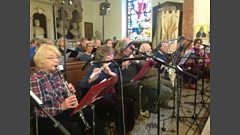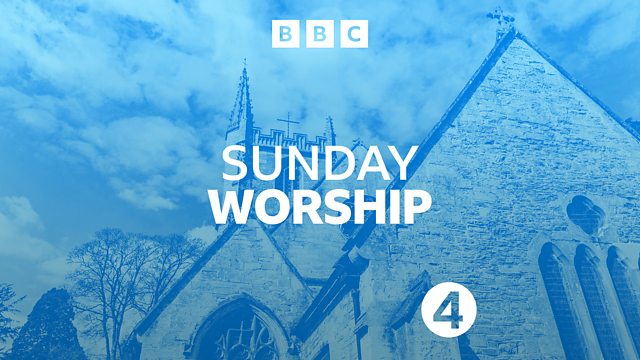
Songs of Innocence and Experience
Marking Holy Innocents from Wesley's Chapel, London, with carols in the West Gallery style. Led by Leslie Griffiths. Preacher: the Rev Prof Ben Quash of King's College, London.
Marking Holy Innocents from Wesley's Chapel London with carols in the West Gallery style. Two hundred years ago, when hymns as we know them were only just coming into use and before mighty pipe organs had appeared, a bunch of local musicians would bring their enthusiasm and energy to the aid of congregations. They'd sing from the west end of the church and often from a specially constructed West Gallery. Robust and earthy some of this music may be but their singing still covered every part of human life with songs of innocence and experience. Leader: The Superintendent, Leslie Griffiths; Preacher: Professor of Christianity and the Arts at King's College London Ben Quash. Music: Awake and join the cheerful choir - Coventry Carol - A Virgin most Pure - While Shepherds Watched their flocks by night - The Magi Carol - O Come all ye Faithful. Music Director: Francis Roads; Producer: Rowan Morton-Gedhill.
Last on
More episodes
Previous
Songs of Innocence and Experience - Script
Please note:
This script cannot exactly reflect the transmission, as it was prepared before the service was broadcast. It may include editorial notes prepared by the producer, and minor spelling and other errors that were corrected before the radio broadcast.
It may contain gaps to be filled in at the time so that prayers may reflect the needs of the world, and changes may also be made at the last minute for timing reasons, or to reflect current events.
The Feast of the Holy Innocents Song: Awake and join the cheerful choir (Lyngham)〶Ä
Welcome and Introduction:Good morning wherever you are. I hope that lively invitation to wake up and join our cheerful choir hasn’t been too much of a rude shock on this fourth day of Christmas when many people across the land will be enjoying a lie-in. Our music today is drawn from a tradition known as the West Gallery because, a couple of hundred years ago, when hymns as we know them were only just coming into use in church services, and before mighty pipe organs had appeared, a bunch of local musicians would bring their enthusiasm and energy to the aid of congregations. They’d sing from the west end of the church and often from a specially constructed gallery. Hence the name. The effervescent style introduced by those groups will mark the way we sing our Christmas music this morning. Many Methodist churches in former years sang their hymns in this fashion, so this programme, from Wesley’s Chapel, the Mother Church of World Methodism, is a fitting place for singing of this kind. The Chapel stands hard by the City of London, the engine house of the British economy, a place that buzzes day and night with life and activity as it conducts its business in the global marketplace. But today the City is quiet, quiet as the graves in the historic cemetery that lies across the road from us. That’s quite a place. Isaac Watts lies buried there, along with Daniel Defoe, George Fox and the Bedford tinker John Bunyan; and they all keep company with one of my special heroes, William Blake. Wesley’s Chapel was less than twenty years old when Blake published his epoch-making collection of poems called Innocence and Experience. And we’re going to use a couple of items from that collection today, the Feast of the Holy Innocents, when we remember the slaughter of baby boys by King Herod. It was the infant Jesus he wanted to kill, of course, but Mary and Joseph had already escaped. They’d fled to Egypt. The massacre of those children figures in this traditional carol, the Coventry carol, where a lullaby for the Holy child is sung against a background of violence and mindless killing.
〶Ä
Song: Coventry Carol〶Ä
Speech:Before we go any further, let’s listen to my colleague Joy Leitch as she reads the story of the Holy Innocents as recorded in the second chapter of St Matthew’s gospel:
〶Ä
Now after the wise men had left, an angel of the Lord appeared to Joseph in a dream and said, "Get up, take the child and his mother, and flee to Egypt, and remain there until I tell you; for Herod is about to search for the child, to destroy him." Then Joseph got up, took the child and his mother by night, and went to Egypt, and remained there until the death of Herod. This was to fulfil what had been spoken by the Lord through the prophet, "Out of Egypt I have called my son."
When Herod saw that he had been tricked by the wise men, he was infuriated, and he sent and killed all the children in and around Bethlehem who were two years old or under, according to the time that he had learned from the wise men. Then was fulfilled what had been spoken through the prophet Jeremiah:
A voice was heard in Ramah,
wailing and loud lamentation,
Rachel weeping for her children;
she refused to be consoled, because they are no more."
〶Ä
Dear Lord, in this season where we rejoice at the birth of a child, keep our ears attentive for the sounds of Rachel’s weeping; and in our sorrow at the suffering of children everywhere, help us to live and work to build a world where our children and our children’s children may laugh and play, grow and mature, in a way that is pleasing to you; through Jesus Christ our Lord, Amen.
〶Ä
It was to children that William Blake looked when he wanted to describe innocence. He felt that it was in them, unspoiled by experience, that some of the deepest understandings of human purpose and identity could be found. Just listen to Jennifer Potter as she reads one of these now.
Speech: Jennifer The Lamb Speech: Ben QuashInnocence
It is a terrible thing to hear of the death of children. And so much death implied in just one brief verse of the New Testament. Artists ever since have ‘unpacked’ the implications of that little verse, bringing home something of the scale of the horror.
Children continue to be defenceless victims of adult violence - often in the name of some great cause (or some great corruption) over which they have no control. This is perhaps why images of the massacre of the innocents seem to have spoken vividly to every age of human history. [Can I refer to recent child abuse scandals here?]
We call Herod’s action the 'massacre of the innocents' because they did not deserve it, and could not defend themselves against it. They were helpless. And in Christian terms this means that they are especially worthy of consideration, for those who cannot defend themselves are to be the first concern of those who are in a position to carry their burdens for them. In continuity with the teachings of Judaism, the same protection is owed to the poor, the orphan, and the widow.〶Ä
Innocence can mean simply ‘helplessness’ - or (to be truer to its etymology) ‘harmlessness’. In this first meaning of ‘innocent’, we have a challenge to face: to find and be in solidarity with those who cannot fend for themselves. To recognise in them a quality of human vulnerability that is a summons to human power to respect and serve it. To realise that the virtues of the strong are only finally proved in the extent to which they recognise and support the weak. William Bake’s poem The Lamb〶Äevokes this vulnerability which is also a summons; this special place that the helpless and the harmless have in God’s regard.They are made by God, and God stands in solidarity with them - as we are to do.
But there is a risk here. Blake’s is a sweet poem, and has been made sweeter by some of its subsequent uses. The risk, therefore, is that in sweetening our notions of innocence we idealise harmlessness, and we also make 'sweet harmlessness' into an ideal for all Christians to emulate. Just because the harmless are close to God’s heart, and those with the resources to do so are called to defend them, does not mean that every Christian should want to be〶Älike them.
Christian innocence is not sweetness. And even children aren’t necessarily always a good example of such innocence. (They’re often not sweet at all.)
Moreover, seeking to be ‘harmless’ could easily mean being ‘toothless’. Not wanting to rock the boat or disturb the status quo.
William Blake wrote〶ÄThe Lamb〶Äwith one eye on〶ÄThe Tyger. He knew that the Lamb, in Christian terms, was also a revolutionary who changed the way the world has thought and acted. For what world movement has ever gathered itself around the memory of Pontius Pilate? The Lamb of God is sent into the world to witness to One who calls it to be better than it presently is. It is not a sentimental symbol of childhood. This Lamb, like Blake’s ‘tyger’, has ventured into the forests of the night, displaying light precisely in order to confront and reveal darkness.
Historical innocence is not something that just sits there, asking to be shielded from the wicked old world and kept ‘pure'. It is something learned and re-learned through speaking God’s justice to human justice, truth to power. It is not innate innocence; it is what we might call〶Älearnt innocence. It〶Äknows it may have to stand before Pilate, as Christ did, and point out the limits of a world-view based only on political expediency.
The Virgin Mary may have been little more than a child herself when she was asked by God to play an extraordinary part in the revolution which was the Incarnation. In responding to this summons, she showed herself to be not so much sweetly innocent as fiercely innocent, as her words in the Magnficat testify. This is not a harmless utterance - it is a disturbing one. Indeed, some scholars have pointed out similarities in its literary form to the military victory hymns sung by Jewish freedom fighters in the Maccabean wars against Roman oppression: ‘he has put down the mighty from their seats, and the rich he has sent empty away.’〶Ä
〶Ä
〶Ä
SONG: A Virgin most pure
Speech: The idea of innocence goes well with simplicity. And simple joy is the quality I always associate with the West Gallery music we are using in today’s service. It was folk music, music of the people, and it always had a rustic feel about it or else something of the street. Musical instruments were a late arrival on the scene, and often came in to help those singing the different parts, people who couldn’t read music, to get their notes right. And the singing was often followed by eating and making merry. All of that sits well with the picture at the heart of our next song, the familiar carol, "While Shepherds watched their flocks by night" though the tune may be a surprise. The Yorkshire anthem, it’s sometimes called, the tune to which "On Ilkley Moor ba’ht hat" is sung. Whenever I hear it, I want to kick out my feet, do a little reel, and join in the fun with heart and voice.〶Ä
Music: While shepherds watched their flocks by night.〶Ä
Speech: William Blake added what he called "experience" to the simple joys of "innocence." Life brings tough times to so many people, it knocks the stuffing out of them. He lived at the beginning of what we now call "the industrial revolution" and he didn’t like the way the "dark, satanic, mills" were affecting people’s lives. There was so much to regret, so much to be fearful of, and nowhere were these forces more in evidence than in our cities, growing fast, too fast, and often blighting people’s lives. Just listen to the poem he calls, quite simply, "London."〶Ä
Jennifer
London.I
Speech: Ben QuashExperience
William Blake was something of a prophet in his own day [example]. So were the Wesleys, who felt that the church they belonged to had become toothless; too happy with a particular status quo. Christian disciples, like OT prophets,〶Ähave wanted to disturb the status quo. They have wanted to change things.〶Ä
Does this mean we could never describe a prophet as innocent? I don’t think so. The prophets conjured visions of a less abusive and more just world (in this sense a more ‘innocent' world)〶Äto hold up in front of self-interest and ingrained cynicism as a tool of change. Their visions were passionate and sometimes fierce (not our conventional idea of what ‘innocence’ is), but they were also purifying and zealous. And they were properly embedded in history, and the challenges of historical responsibility.〶Ä
Blake’s work - visual as well as literary - represents a recovery of a sort of ‘pastoral’; a sort of romanticism. He is often mentioned in the same breath as that artist of mystical scenes of rural England, Samuel Palmer. But Blake’s romanticism was a political tool. It was ‘urban romanticism’ or what one recent scholar has called ‘broken pastoral’. It acknowledged the wickedness of the world, its vested interests and stuck ways. The alternative vision it sought to offer was ‘innocent’, but not naive. It was geared to change.
[Detailed discussion of London〶Ähere: Blake’s dark fury at the failures of the establishment: Monarchy, Church, military etc. The triumph of commerce which turns into property (‘charters’) even what ought to have been natural and free (the river). The concern with victims and the helpless - including children. Weakness is not an ideal to strive for. Marks of weakness are marks of woe. Blake wants to empower a different innocence: an innocence that strives for transformation. The first letters of the four lines of stanza 3 spell out the prophetic injunction ‘HEAR’.]
〶Ä
It’s easy to think of prophets as misfits and outsiders. But I’ve heard prophets much better described: as those who suffer from an ‘excess of belonging’. They make trouble because they care so much. They are hyper-committed to the world they want to change, and their vision of how its blameful ways could be made more innocent again (i.e. less systematically, relentlessly damaging to the ‘lambs' amongst us) only makes them look like they don’t belong. In fact, they model a better belonging, and call us to belong to a world better than ourselves.
When I teach Blake’s poem London〶Äto my students, they often begin by saying ‘what a negative view of the city he has’; or ‘how he seems to loathe it’. But they quickly realise that this Londoner born and bred (Blake barely left the city his whole life) deeply loved the city that was his home - just as the Wesleys loved the church they critiqued and challenged. London was a place in which Blake saw angels.〶Ä
〶Ä
ã€¶Ä Song: If the shepherds who greeted the birth of Jesus can be associated with innocence, the wise men (the Magi) can certainly be thought of as having experience. Their dealings with King Herod as they looked for the baby Jesus and also as they dealt with his attempts to trick them into yielding information before they set out on their journey home, suggests that. The story of those wise men belongs properly to the twelfth day of Christmas, the day we call Epiphany, but it does no harm to think of them here. We’re all of us familiar with the dangers and difficulties, the troubles and woes, of life. In a sense, their experience of double dealing and political pressure prefigures so much of the shadow side of human life. So we bring them into the story now as we sing the Magi Carol.〶Ä
Song: Magi Carol. – No Kingly robes or golden treasure〶Ä
Prayers and Blessing:〶Ä
LeslieDear Lord, hear us as we pray on this Holy Inncocents’ Day for children
everywhere who need our prayers. We pray for:
〶Ä
Jennifer and Joy
· Children living in war zones, surrounded by death or injury, within the sound of battle, traumatised, victimised, afraid;
· Children living in refugee camps, often as orphans, filled with uncertainty, riddled with fear;
· Children living in areas afflicted by disease, witnessing the death of loved ones, scared that they might be the next to go;
· Children whose labour is exploited, who work long hours as virtual slaves, to earn a pittance for their families;
· Children who are abused or trafficked, treated with cruelty, used as sex objects, lonely and terrified;
· Children suffering from incurable disease, lying on sick beds at home or in hospital; facing a darksome future;
· Children in care, abandoned by their families, in trouble with the law, unable to live normal lives;
· Children whose rights are flaunted, whose innocence is stolen and whose childhood destroyed.
Leslie
Dear Lord, as we pray for children in need, so too we pray for all organisations or institutions that work to protect and cherish them. May they see the day when their work will no longer be needed.
These and all our prayers we offer in the name of Jesus Christ our Lord whose own childhood we celebrate in this season. Amen.
Arise and hail the glorious star
The Lord’s Prayer
The Blessing
〶Ä
Song: O come all ye faithfulNotes on Carols
Carols sung for Â鶹ԼÅÄ Radio4 Morning Worship 28th December 2014.<?xml:namespace prefix = o ns = "urn:schemas-microsoft-com:office:office" />
Notes by Francis Roads, who edited all the carols for performance.
1.ÌýÌýÌý Awake and join the cheerful choir
The text is anonymous, but has been found set Ìýto many tunes.Ìý Lyngham, by Thomas Jarman (1776-1861), is such a fine West Gallery tune that it survived the reforms of the Victorian era, and appears in some modern hymn books, though in a simplified version, with some of Jarman’s counterpoint omitted. Jarman, like so many West Gallery composers, was an amateur composer; his day job was as a tailor, but he turned increasingly to music, and published several sets of hymn tunes and other sacred music.Ìý
2.ÌýÌýÌý ÌýLully, lullay, thou little tiny child (Coventry carol)
This carol is the second of three included in the mediaeval Pageant of the Shearmen and Taylors. An extended essay on the origin of this carol by Nicholas Markwell is subjoined.ÌýÌýÌýÌýÌýÌý ÌýÌýÌýÌýÌýÌýÌýÌýÌýÌýÌýÌýÌýÌýÌýÌýÌýÌýÌýÌýÌýÌýÌý
ÌýÌýÌýÌýÌýÌýÌýÌý 3.ÌýÌý ÌýA Virgin most pure, the prophets foretold (A Christmas Carrol)
This carol appears in the present form in William Knapp’s publication Anthems for Christmas Day , published in London in 1743 by William Knapp (c1698-1768). Knapp, like Jarman, was an amateur composer, whose day job was as a glover. Professor Temperley’s Hymn Tune Index (Oxford 1998) firmly attributes the tune to Knapp himself. But both text and melody appear in the folk tradition in many different versions, and it may be that Knapp published his own arrangement of a carol that already existed.ÌýÌýÌýÌýÌýÌýÌýÌýÌýÌýÌýÌýÌýÌýÌýÌýÌýÌýÌýÌýÌýÌýÌýÌýÌýÌýÌýÌýÌýÌýÌýÌýÌý
4.ÌýÌýÌý While shepherds watched their flocks by nightÌýÌýÌýÌýÌýÌýÌý
This well-known text is a paraphrase by Tate and Brady of Luke II 8-14, and appended to their New Version of the Metrical Psalms, first published in 1696. While carols as such were regarded as too secular in style for rendition in church in the West Gallery period, this text was acceptable, as it is scriptural. There are therefore hundreds of settings, as each local quire adapted the text to one of their own tunes.
The Tune Cranbrook, by Thomas Clark of Canterbury (1775-1868) was published in his A Sett of Psalm and Hymn Tunes Ìý(London 1805), originally with the text of the hymn Grace, ‘tis a charming sound, by Philip Doddridge (1702-51) [Image available]. Clark was another amateur composer, who worked in Canterbury as a boot and shoemaker.
In accordance with common West Gallery practice, such a fine tune was soon adapted to other texts, including the present one. Much later, it was adapted to a secular text often sung in Yorkshire, On Ilkla Moor baht ‘At. But the tune itself is Kentish sacred music
5. ÌýArise and hail the glorious starÌýÌýÌýÌýÌýÌýÌýÌýÌýÌýÌýÌýÌýÌý
This fine tenor-led carol appears in many West Country manuscripts. Both text and music are anonymous.
6. ÌýNo kingly robes nor golden treasureÌýÌýÌý
This carol appears in a two part version in Davies Gilbert’s Some Ancient Christmas Carols (London 1822) which appears to be the first printed publication of such material. Gilbert’s somewhat unconventional bass has been retained, but the inner parts are the work of the editor.
ÌýÌýÌýÌý ÌýÌý7. ÌýO come, all ye faithful ÌýÌýÌýÌýÌýÌýÌýÌýÌýÌýÌýÌýÌýÌýÌýÌýÌýÌý
Both text and the tune New Portugal are attributed to John Francis Wade (c1711-86). In the West Gallery period the tune was more frequently sung to the text O Come, Loud Anthems Let us Sing (Psalm 95 New Version), and to many other texts. Performance in those days had a much faster tempo than has become customary nowadays. The instrumental symphonies are from David Weyman’s Sequel to Melodia Sacra (Dublin 1850).
Ìý
Notes by Nicholas Markwell on the origin of The Coventry Carol
"The Coventry Carol" is the second of three carols surviving in music manuscript as part of the medieval Pageant of the Shearmen and Taylors. The original ms was held in the Birmingham Free Reference Library until 1879, when the library was destroyed by fire. Fortunately, a copy had been made by Thomas Sharp, as part of his "A Dissertation on the Pageants or Dramatic Mysteries, anciently performed in Coventry, by the trading companies of that city: chiefly with reference to the vehicle, characters, and dresses of the actors. ...To which are added the Pageant of the Shearman & Taylors' Company, etc.", which he published in 1817, followed by a second edition in 1825. Sharp has been much criticised by some modern scholars for "a horrendously inaccurate piece of engraving" (Hugh Keyte and Andrew Parrott, The New Oxford Book of Carols, 1992), but having studied his facsimile, I have to say that in my opinion, this does him a great disservice.I believe that Sharp copied the original ms fastidiously, although, of course, the evidence can only be circumstancial. He has preserved not only the original diamond-shaped notation, but also the many variants in spelling. It's clear that the text of the bass of the original ms was written by a different scribe, as the spelling is so idiosyncratic. These differences have led to various inaccuracies and confusion in modern editions, not helped by the fact that the text of the carol is written separately from the music, as well as for each of the three parts being underlaid. There are therefore four differing versions of the text. Rather than reproduce all four versions here, I have chosen to compare the separate text, and the text underlaid to the basse part.
The version written separately (and taken as the sole source in modern editions) reads as follows:
Lully Lulla thow Littell tyne child
by by Lully Lullay
thow Littell tyne child
by by Lully Lullay
O sisters too how may we do
For to preserve this day
This pore yongling for whom we do singe
By by lully lullay
Herod the king in his raging
Chargid he hath this day
His men of might in his owne sight
All yonge children to slay
That wo is me pore child for thee
and ever morne and say
for thi parting nether say nor singe
by by Lully Lullay
The three parts are designated "The treble", "The tenor", and "The basse" respectively. The text underlaid in the basse part reads as follows:
Lully Lullaye thow Littell tyne child
by by Lullie Lullay
thow Littell tyne child
by by Lully Lullay
O sisters two howe maie we do
for to preserve this daye
oure pore yongeling for whom wee do singe
by by Lullie Lullay
Herode the Kinge in his raginge
charged he hathe this daie
his men of mighte in his owne sighte
all yonge children to slaye
That wo is me pore child for thee
and ever morne and say
for thi partinge nether saie nor singe
by by Lully Lullay
Punctuation is entirely absent, except in the treble, where full stops are provided at the end of the refrain, and verses 1 and 2, but curiously not at the end of verse 3. Note the substitution in the basse of "oure" for "this" in the third line of verse 1, and "Lullaye" for "Lulla" in the first line of the refrain. Importantly, both the tenor and basse preserve the correct reading in verse 1: "O sisters two", rather than "too" given in the separate text and in the treble. Also of note is the reading in all parts in verse 3:
"and ever morne and say
for thi parting nether say nor singe"
The first of these lines is usually altered in modern editions to read "and ever morn and day", which is a mis-reading of "morne" as an abbreviation of "morning", thus requiring the alteration of "say" to "day". In fact, as Keyte and Parrott point out, "morne and say" means "mourn and sigh" in modern English. The spelling of "nether" may well indicate that the first syllable should rhyme with "knee".
If Thomas Sharp had followed the convention of his day, he would no doubt have been expected, given that this ms formed part of his dissertation, to standardise the various spellings. That he did not is to his credit, and leads now to the music. It is to this aspect that Keyte and Parrott's reference to "a horrendously inaccurate piece of engraving" refers. It is quite true that there are more than a few errors in the musical notation, but again, had Sharp followed the scholarly conventions of his day, he would have corrected these obvious errors without comment.
Musically, his copy preserves the diamond-shaped noteheads, and also the repeat sign used in the 16th century, similar to today's Dal Segno sign. Again, in my opinion, this is further evidence of his fidelity.
There are three notable differences between Sharp's copy and most modern editions. The first is the false relation in the verses between the tenor F natural and the treble F sharp, on the second "by" of the last line. This is entirely in keeping with 16th century idiom, and it is a great shame that most modern editors (your own edition being an honourable exception) edit this out by transposing this and the following note in the tenor down a third.
The second is the ending of the treble in verse 2 referred to above. Here, Sharp gives the last three notes as G, F (natural) G, rather than the modern C, A, B natural. Keyte and Parrott keep Sharp's reading, except that they add a sharp to the F. The third difference (as found in your own edition) is that Sharp gives the last note of the third line of the verse as an F natural. Here, I am in agreement with most modern editions which add a sharp, as this makes more sense, given the identical line in the second half of the first line. Again, I believe the omission of the accidental to be an error which Sharp faithfully copied from the original ms.
Without exception, as far as I am aware, all modern editions attribute this carol to the long-lived and prolific "anon". This is wrong. The ms informs us that the text is by Thomas Mawdycke (probably pronounced "Mawdick") and the music by Thomas Nycles (the modern spelling "Nicholls" giving a clue to the pronunciation). Also given is the date of the original ms: May 13, 1591. Given that the melody is likely to have been written up to a century-and-a-half earlier, it's likely that Thomas Nycles was the arranger, rather than the composer.
The ms may be seen at the British Library, shelfmark G.501. Another copy is available on Document Supply, which may be loaned to most lending libraries.
Broadcast
- Sun 28 Dec 2014 08:10Â鶹ԼÅÄ Radio 4


